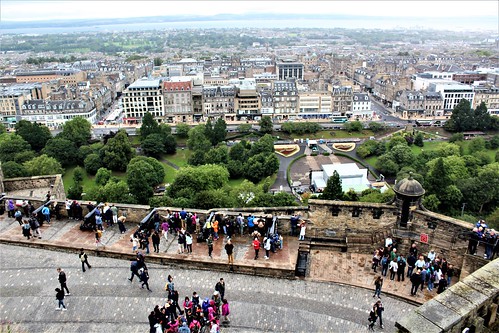Edinburgh Castle, Scotland
Edinburgh Castle sits atop a natural fortification in form of an ancient volcanic plug the elevation of which offers superb views over Edinburgh, Firth of Forth and other aspects of the local landscape. The castle changed hands many times during the Anglo-Scottish Wars of medieval times. Most of the castle buildings today date from the 16th and 17th centuries. The castle is particularly noted for:
- It’s role as a venue for the annual Royal Edinburgh Military Tattoo during August.
- The One o’Clock Gun.
- A place of safekeeping for the Honours of Scotland (Crown Jewels).
- As a repository for the Stone of Scone (Stone of Destiny).
The castle is a large and complex site. Here is a list of key features which will normally be encountered in course of a two hour visit:-
→Argyll Battery: Offering a display of cannon and panoramic views over Princes Street below.
→One O’Clock Gun: Stands on Mills Mount Battery and has been fired each weekday since 1851, originally as an aid to navigation for ships in the waters below.
→St. Margaret’s Chapel: Private chapel of Queen Margaret dating from 1076. The oldest building in Edinburgh.
→Mons Meg: Giant 15th century cannon presented to King James II of Scotland by the Duke of Burgundy in 1457.
→Dog Cemetery: Small graveyard for regimental and soldiers dogs visible over the wall from near Mons Meg.
→Half Moon Battery: Dates from 1574 on site of David’s Tower.
Crown Square is the heart of the castle
In and around the Square are the following:
→Palace: Also known as King’s Lodging where Mary Queen of Scots gave birth to the future James VI (Scotland) I (England).
→Crown Room: Here are the Honours of Scotland including crown, sceptre, sword and other items of Scottish regalia.
→Stone of Scone: A historic block of sandstone of which Scottish monarchs at during coronations.
→Great Hall: Dates from 16th century. Noted for its elaborate timber roof and display of arms and armour.
→Scottish National War Memorial: Inaugurated in 1927 to commemorate the Scots dead of World War I.
→POW Exhibition: In old vaults which date from past conflicts including the Napoleonic Wars.
There are three options for visitors:
- Explore at own pace.
- Join one of the guided tours which operate at frequent intervals from a starting point near the Argyll Battery.
- Avail of a self-guided, audio tour.










Comments
Post a Comment